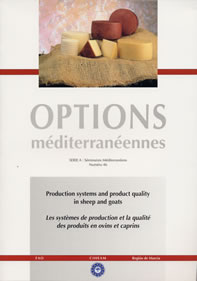| Article précédent | p. 41-44 | Article suivant |
Effects of the rearing system on meat quality in young kids
Thirty twin male kids were allotted to two rearing systems based on feeding regimes: 15 kids nursed by their dams (ND), or 15 kids fed a commercial milk replacer and controlled intake (CR). They were slaughtered at a 10 kg live weight. After slaughter, pH was measured on the Longissimus dorsii (LD), Semimembranosus (SM) and Triceps brachii (TB). Carcasses were chilled for 24 h, and pH, Warner-Brazler shear force (WBSF), colour and water holding capacity (WHC) were determined in the LD, SM and TB muscles. Compared with the ND-raised kids, the TB muscle from CR-raised kids had higher L and lower WHC and pH 24-h postmortem. TB muscle had a higher final pH, greater firmness, and a lower WHC than the LD and SM muscles. In this experiment, raising goat kids on a commercial milk replacer, rather than suckling from their dams, had minimal effects on their meat quality.
- [ Afficher ]
- [ Télécharger ]
- [ Exporter la citation ]
Vous pouvez télécharger la citation au format :
- [ Imprimer ]
-
Mots-clés
ALIMENT D'ALLAITEMENT, CHEVREAU, QUALITE, VIANDECiter cet article
Argüello A., Ginés R., López J.L., Capote J. Effects of the rearing system on meat quality in young kids. In : Rubino R. (ed.), Morand-Fehr P. (ed.). Production systems and product quality in sheep and goats . Zaragoza : CIHEAM, 2001. p. 41-44. (Options Méditerranéennes : Série A. Séminaires Méditerranéens; n. 46). Meeting of the Sub-Network on Production Systems of the FAO-CIHEAM Inter-Regional Cooperative Research and Development Network on Sheep and Goats, 1999/09/23-25, Molina de Segura-Murcia (Spain). http://om.ciheam.org/om/pdf/a46/01600110.pdf



